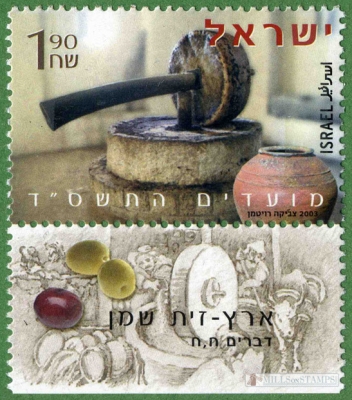-
Festivals. olives and olive oil
Israel 2003.09.09
In issue: Stamp(s): 3 Booklet(s): 1
Printing: with phosphor bands
Issued in: sheets of 10 stamps and 5 labels and in booklet of 6 (3+2+1) stamps
-
Number by catalogue: Michel: 1746 Yvert: 1678 Scott: 1537 Gibbons: 1666
Perforation type: 14x14
Subject:
1.9 shekels.
Manual oil millstones. On the coupon there is an image depicting the use of animal-driven millstones to oil pressing.
Topics: Cattle mills Manual and Kitchen mills Olive oil and wine mills
-
Number by catalogue: Scott: 1538a
Perforation type: 13 ¾x14
Subject:
The booklet contains a different quantity of stamps in the series, with a total value of 12 shekels.
The cover uses the same storyline as the stamp above - pressing oil from tins on animal-driven millstones.
Additional:
Olive pits have been discovered in Israel dating back 6,000 years, and centuries-old olive orchards still thrive here. The first trees of Israel's modern olive industry were planted in the early 1990s.
Today, Israel has about 81,000 acres of olive orchards, which annually produce about 16,000 tons of olive oil (EVOO). Most of Israel's oil is destined for domestic use, and about 1,000 tons are exported mainly to the United States. At least 10,000 tons of Israeli olive oil is produced from modern orchards, with the rest produced by traditional and family-owned gardens run by both Arab and Jewish farmers. They are located between Metulla, Israel's northernmost city on the Israel-Lebanon border, all the way to southern Eilat. In the village of Deir Hannah in the Lower Galilee, it is perhaps the oldest olive tree in Israel, dating back more than 900 years.
A liter bottle of olive oil contains between four and six kilograms of olives, which equates to approximately 1,000 individual fruits, and as a nation, Israelis consume about 2.5 kilograms of extra virgin oil per person per year.
According to Jewish law, olive oil was the only fuel used in the seven-light menorah in biblical times and later in the permanent temple in Jerusalem. It was obtained using only the very first drop of a squeezed olive, consecrated for use by priests, and kept in special containers. The kings of Israel have been anointed with olive oil since King David.
In the old days olives were pressed in huge stone bowls using stone millstones. A horse, cow or donkey was tied to the millstones, which walked in a circle, rotating the millstones and chopping the olives poured into stone bowls.
Israelis travel to olive groves and oil mills every year, to olive oil festivals. Typically, festivals take place in the same months as the harvest.
__________
This information has been taken from Tourist Israael web page.
Size (of sheet, booklet) mm: 200x50
Topics: Cattle mills Manual and Kitchen mills Olive oil and wine mills




